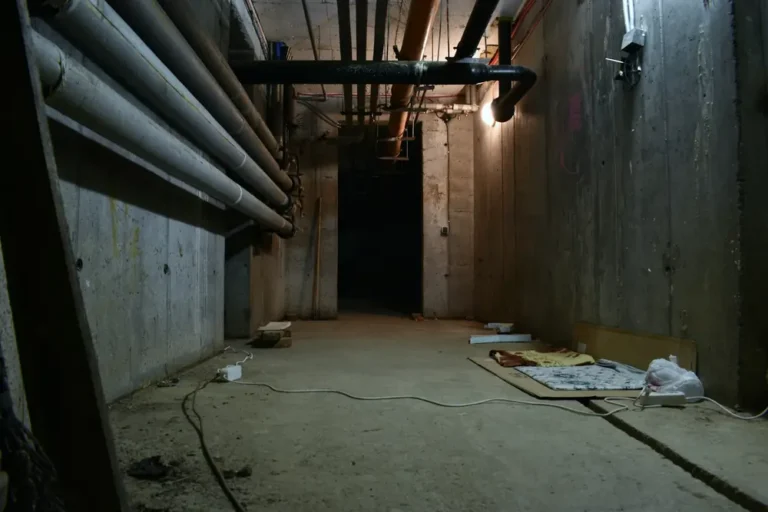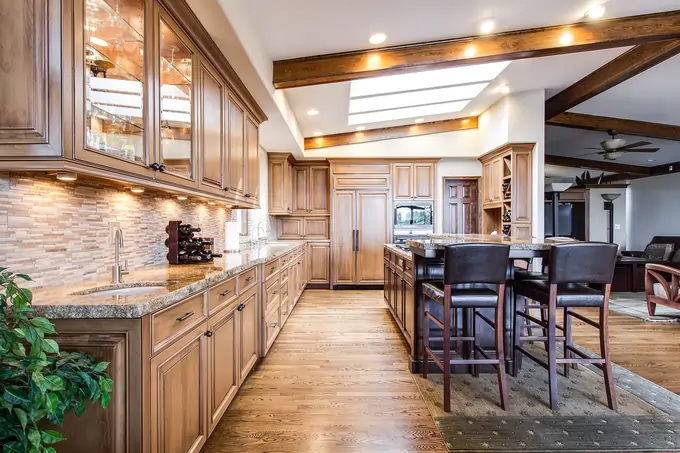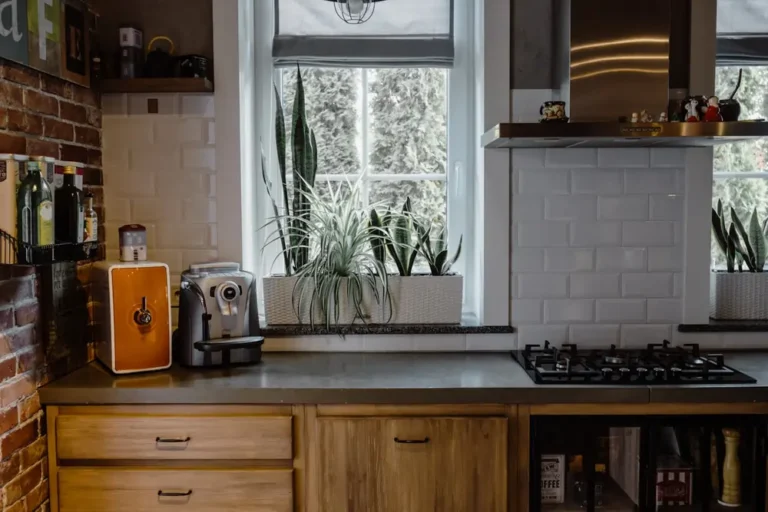Are you tired of dealing with a damp, musty basement? Do you worry about potential flooding every time it rains? If so, you’re not alone. Many homeowners face the challenge of keeping their basements dry and safe. In this comprehensive guide, we’ll explore everything you need to know about basement drainage systems and how they can protect your home from water damage.
Basement Drainage System
Nobody likes a wet basement. It can lead to structural damage, mold, and just plain headaches. If you’ve ever walked down into your basement only to find puddles or, worse, a flood, you know exactly what I mean! The good news is, a reliable basement drainage system can save the day. In this guide, we’ll walk you through everything you need to know about basement drainage systems—from the different types to how to install and maintain them. Whether you’re building a new home or looking to fix ongoing water issues, these tips will help keep your basement dry for years to come.
Water Damage Risks to Your Home’s Foundation
Hey there! If you’re worried about water damage to your home’s foundation, you’ve got to think about your interior basement setup. Issues can start with your basement wall or basement floor and get worse without a good drain system. A drain tile system or french drain system can help collect water and keep it away from your foundation.
Whether you have a crawl space or a finished basement, it’s crucial to have a reliable basement system. Interior basement drainage and a solid interior basement drainage system are key. Think about adding a basement drain or even a floor drain to manage water flowing from basement windows and other areas.
For the best basement protection, consider interior basement waterproofing and interior basement waterproofing solutions. A good water drainage system around the interior perimeter can make a huge difference. Basement waterproofing system options like french drain installation and exterior waterproofing can also help safeguard the perimeter of the basement.
Water is the silent enemy of your home’s foundation. Over time, excess moisture can lead to:
- Cracks in your foundation walls
- Mold and mildew growth
- Weakened structural integrity
- Decreased property value
But what if there was a way to prevent these issues before they start? (Hint: There is, and we’ll get to that soon!)
Common Causes of Basement Flooding
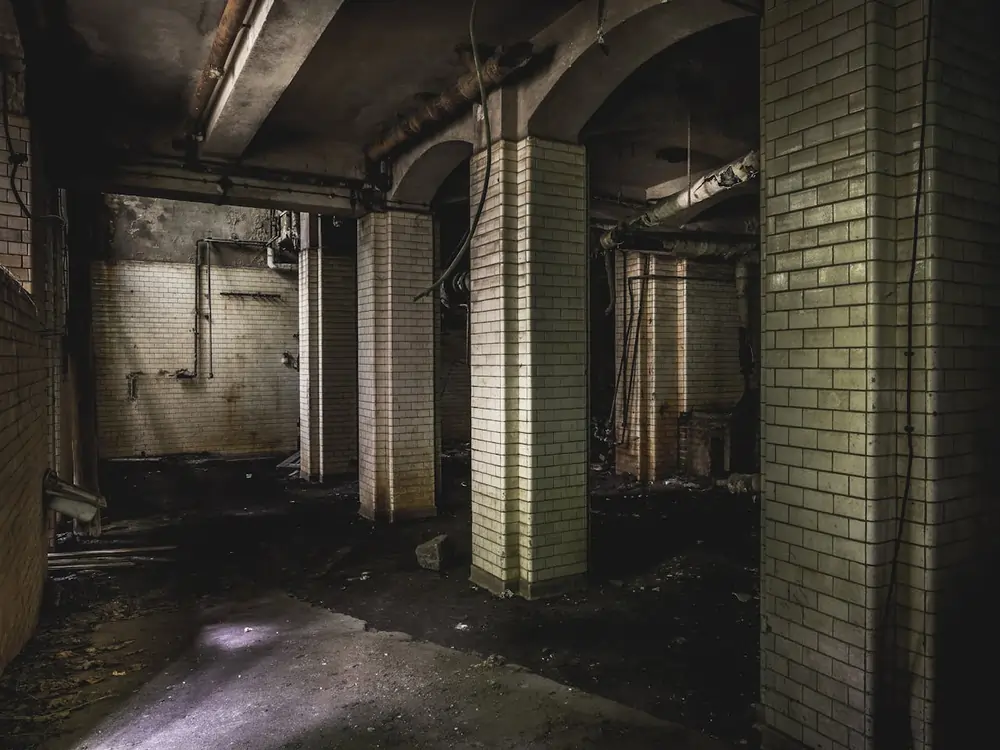 Common causes of basement flooding often include issues with perimeter drainage and drain outlet systems. To avoid damage to your basement, it’s crucial to waterproof your basement and ensure proper crawl space repair. One effective method is to install an exterior waterproofing membrane to keep water away from your basement.
Common causes of basement flooding often include issues with perimeter drainage and drain outlet systems. To avoid damage to your basement, it’s crucial to waterproof your basement and ensure proper crawl space repair. One effective method is to install an exterior waterproofing membrane to keep water away from your basement.
If water finds its way into your basement, consider a baseboard waterproofing system. This drainage system along the basement along the walls helps direct water to a drain outlet. The best waterproofing approach is a comprehensive perimeter drainage system that includes a battery backup system to handle power outages.
For a free basement from water issues, it’s essential to install the system correctly. Whether you live throughout New York or elsewhere, a reliable baseboard drainage system can prevent water from entering the basement. Remember, the system is the first line of defense against flooding, and a well-installed system is key to maintaining a dry and safe basement or crawl space.
Before we dive into solutions, let’s identify the culprits behind basement water problems:
- Poor soil grading
- Clogged gutters and downspouts
- Hydrostatic pressure
- Faulty plumbing
- Natural disasters
Understanding these causes is crucial for implementing effective wet basement solutions.
Benefits of Installing a Drainage System Early On
Getting a drainage system installed early on can save you a lot of headaches. Imagine never worrying about water entering your basement because you have a basement water control system in place. This system is designed to keep your basement dry and cozy.
With free basement waterproofing options available, there’s no reason to wait. An interior drain system and built-in wall drainage can handle the water, while a pump will run to keep things dry. Plus, a good surface drainage system can help manage water before it even becomes an issue.
Don’t forget about exterior basement waterproofing to add an extra layer of protection. Whether it’s a new concrete slab or an existing one, a basement drainage system requires proper planning. So, think about installing a drain system today for a free basement check.
Overall, basement drain systems are a smart investment. A well-designed system can also prevent future damage, saving you money in the long run. So, get your basement since it’s a space worth protecting!
Imagine never having to worry about water damage again. By installing a basement drainage system early, you can:
- Prevent costly repairs
- Increase your home’s value
- Create a healthier living environment
- Gain peace of mind during heavy rains
But what exactly does a drainage system entail? Let’s explore the options.
Types of Basement Drainage Systems
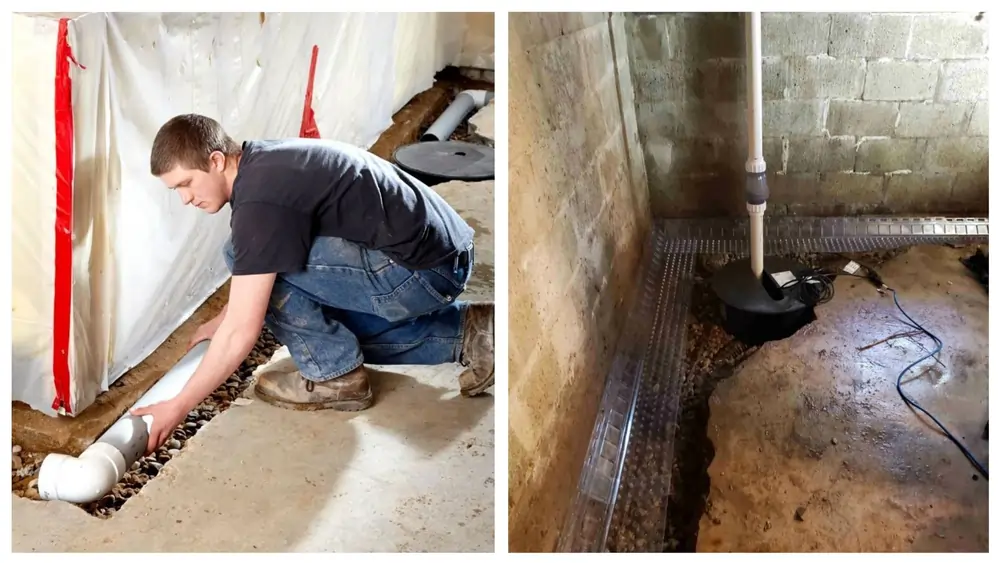 There are a few types of basement drainage systems you can look into. One common option is a French drain, where a system is installed around the perimeter to channel water away. Another is a sump pump system designed to collect and pump the water out of your basement. Finally, there’s the exterior waterproofing method, which involves sealing the outside of your foundation.
There are a few types of basement drainage systems you can look into. One common option is a French drain, where a system is installed around the perimeter to channel water away. Another is a sump pump system designed to collect and pump the water out of your basement. Finally, there’s the exterior waterproofing method, which involves sealing the outside of your foundation.
Interior Drainage Systems
- French drains: These perforated pipes redirect water away from your foundation.
- Sump pumps: Automatically pump excess water out of your basement.
- Drain tiles: A network of pipes that collect and channel water away from your home.
Exterior Drainage Systems
- Waterproofing membranes: Applied to exterior foundation walls to prevent water infiltration.
- Exterior drain tiles: Similar to interior drain tiles but installed outside the foundation.
Pros and Cons of Each System
Interior systems are less disruptive to install but may require more maintenance. Exterior systems offer comprehensive protection but can be more expensive and invasive to install.
How to Choose the Right Drainage System for Your Home
Factors to consider:
- Soil type
- Climate
- Budget
- Home age and construction
How to Install a Basement Drainage System
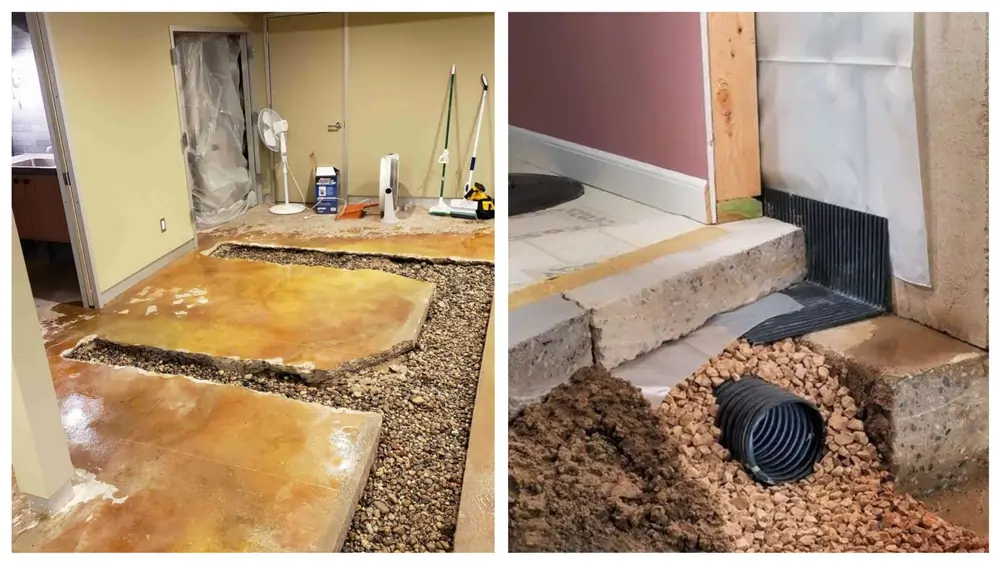 DIY vs. Professional Installation: Which is Right for You?
DIY vs. Professional Installation: Which is Right for You?
While some homeowners may be tempted to tackle installation themselves, professional installation often yields better results. Here’s why:
- Expertise in assessing your specific needs
- Access to specialized equipment
- Warranty protection
- Faster completion time
Step-by-Step Guide to Installing an Interior Drainage System
- Excavate a trench along the perimeter of your basement
- Install a perforated pipe in the trench
- Connect the pipe to a sump pump
- Cover the pipe with gravel and concrete
Key Tools and Materials You’ll Need
- Jackhammer
- Perforated pipe
- Gravel
- Concrete mix
- Sump pump
Common Installation Mistakes to Avoid
- Improper grading
- Inadequate pipe sizing
- Neglecting proper sealing
- Insufficient slope for drainage
Signs Your Basement Drainage System Needs Maintenance
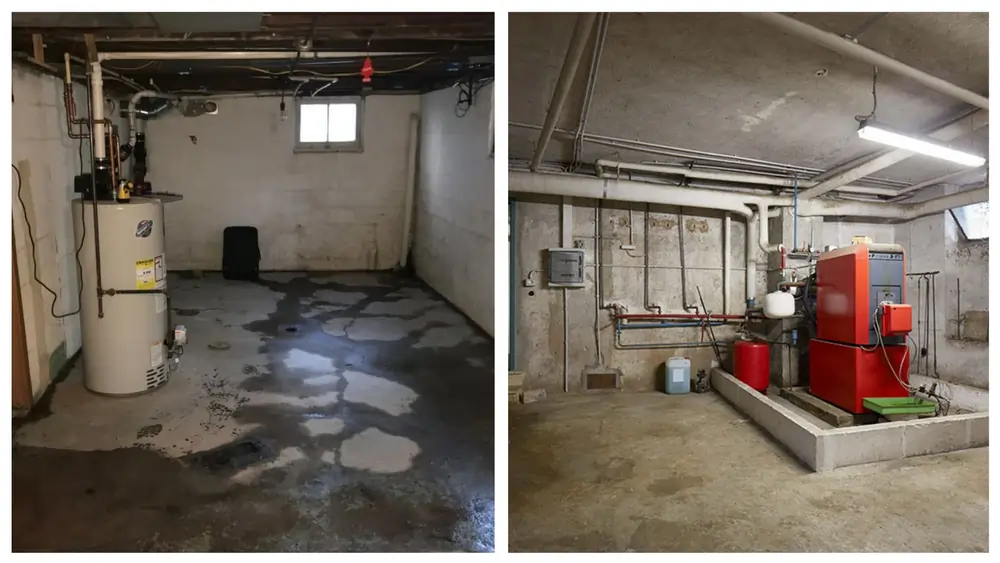 Early Warning Signs of Drainage System Failure
Early Warning Signs of Drainage System Failure
- Musty odors
- Water stains on walls or floors
- Increased humidity
- Mold growth
How to Inspect Your System Regularly
- Check for clogs in pipes
- Test your sump pump monthly
- Look for signs of water seepage
- Monitor humidity levels
Simple Maintenance Tips to Extend the Life of Your System
- Clean gutters and downspouts regularly
- Grade soil away from your foundation
- Install a battery backup for your sump pump
- Seal cracks in foundation walls
When to Call a Professional for Repairs
If you notice persistent leaks, strange noises from your sump pump, or significant cracks in your foundation, it’s time to call in the experts.
Cost of Installing and Maintaining a Basement Drainage System
Average Cost Breakdown for Interior and Exterior Systems
- Interior systems: $5,000 – $15,000
- Exterior systems: $10,000 – $30,000
Factors That Influence the Cost
- Home size
- System complexity
- Local labor rates
- Soil conditions
Budgeting for Annual Maintenance
Set aside $300 – $500 annually for routine maintenance and inspections.
Cost vs. Benefits of a Long-Term Drainage System Investment
While the upfront cost may seem high, consider the potential savings:
- Avoided water damage repairs: $5,000 – $50,000+
- Increased home value: Up to 10% increase
- Lower insurance premiums
- Improved health from reduced mold exposure
Preventing Basement Water Damage Beyond Drainage Systems
Additional Waterproofing Tips
- Apply waterproof sealants to walls and floors
- Improve landscaping to direct water away from your home
- Install window wells with proper drainage
- Use dehumidifiers to control moisture levels
Proper Gutter Maintenance to Prevent Water Buildup
- Clean gutters twice a year
- Install gutter guards
- Extend downspouts at least 5 feet from your foundation
How to Ensure Proper Ventilation in the Basement
- Install exhaust fans
- Open windows on dry days
- Use a dehumidifier
- Consider a whole-house ventilation system
Emergency Measures to Take if Flooding Occurs
- Turn off electricity to affected areas
- Remove standing water with pumps or wet vacuums
- Dry out the area with fans and dehumidifiers
- Disinfect all surfaces to prevent mold growth
By implementing a comprehensive basement drainage system and following these tips, you can protect your home from water damage and create a dry, healthy living space. Don’t wait for disaster to strike – take action now to safeguard your home and peace of mind.
Conclusion
A basement drainage system is essential to protect your home from costly water damage. By choosing the right system, installing it properly, and maintaining it over time, you can ensure a dry, healthy basement. Whether you’re looking to prevent flooding or fix an existing issue, the right drainage system is the key to long-term peace of mind. Don’t wait until water issues get worse—act now and enjoy a dry basement year-round!
Call to action: Ready to install a drainage system or upgrade your current one? Share your experience in the comments below or reach out to a local contractor for personalized advice!
Remember, a dry basement is more than just a convenience; it’s an investment in your home’s future. So, are you ready to take the first step towards a waterproof basement? The solution to your wet basement woes is just a phone call away. Contact a local basement waterproofing expert today for a free consultation and start your journey to a drier, safer home.
